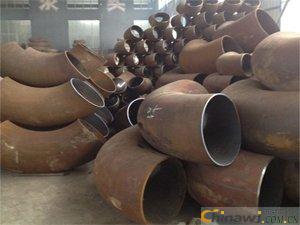The push elbow has a specific expansion rate. According to theoretical calculations, the general expansion rate ranges from 33% to 35%, and it is then pushed back. For example, a short-radius elbow with a diameter of 219 mm typically has an expansion ratio of around 50%. Once the raw materials are selected, they are cut according to the specifications of the curved elbow, taking into account the radius of curvature. A 90° elbow, for instance, can be calculated using the length of the material. This calculation is done theoretically, and then the material is cut to a fixed length. After that, the material is hot-pressed. The pushing process might seem complex, but in reality, it's quite straightforward. It involves a horn-shaped core or mandrel. The mandrel is designed to expand and contract as needed. The pushing process essentially bends and expands the tube along the mandrel. There is support at the rear, where the cut pipe section is inserted into the mandrel, and a rear frame holds it in place. In the middle, there’s a trolley—some are driven by hydraulic pressure, while others use mechanical transmission, such as screw drives. The trolley pushes the tube forward along the mandrel. An induction coil is placed outside the mandrel to heat the tube during the process. As the trolley moves forward, the heated tube is shaped into an elbow. However, improper handling during this process can lead to distortion, which must be avoided. After the initial push, the front end of the elbow often has a larger outer diameter. To correct this, a shaping die is used. The shaping die functions like a press, consisting of two semi-circular molds on either side. This ensures the final product meets the required outer diameter specifications. GB elbow | flange blind plate | push elbow | welding elbow professional manufacturer Cangzhou Xin Dingsheng Pipeline Complete Equipment Manufacturing Co., Ltd., service hotline.

A manual Hydraulic Pump is a device used to generate hydraulic pressure manually. It is typically used in applications where a power source is not available or where precise control of pressure is required.
The pump consists of a handle or lever that is manually operated by the user. When the lever is moved, it activates a piston or plunger inside the pump, which pressurizes the hydraulic fluid. The pressurized fluid is then directed to the hydraulic system through a series of valves and hoses.
There are different types of manual hydraulic pumps, including hand pumps, foot pumps, and air-powered pumps. Hand pumps are the most common type and are operated by hand-cranking a lever or rotating a handle. Foot pumps are operated by stepping on a pedal or lever with the foot. Air-powered pumps use compressed air to generate hydraulic pressure and are often used in industrial applications.
Manual hydraulic pumps are commonly used in a variety of industries, including automotive, construction, and manufacturing. They are used to power hydraulic tools, lift heavy objects, and operate hydraulic machinery. They are also used in hydraulic testing and calibration applications, where precise control of pressure is required.
Overall, a manual hydraulic pump is a versatile and reliable tool that allows for the generation of hydraulic pressure without the need for an external power source.
Manual Hydraulic Pump,Manual Hydraulic Hand Pump,Hand Operated Hydraulic Pump,High Pressure Hydraulic Manual Pump
Yantai Dongyue Hydraulic Technology Co., Ltd , https://www.deeleap.com
